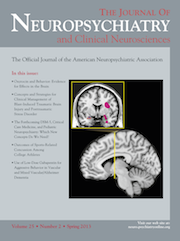Serotonin Syndrome With Ziprasidone and Sertraline
To the Editor: Serotonin syndrome is a potentially life-threatening medical condition characterized by mental status changes, neurologic abnormalities, and autonomic instability.1 It results from a combination of serotonergic agents, and, in some cases, monotherapy alone.2
Case Report
“Ms. L.,” a 30-year-old woman with no past medical history was being treated with ziprasidone 40 mg/day and paroxetine 30 mg/day for major depressive disorder. Paroxetine was discontinued, and sertraline 50 mg/day was initiated for persistent depressive symptoms. Sertraline was titrated to 125 mg/day in Week 4, with ziprasidone maintained at 40 mg/day. Two days later, the patient was brought to the emergency room for severe anxiety, jerking movements of upper extremities, and transient headaches. At presentation, her blood pressure was 134/92 mm Hg, heart rate, 122 beats per minute, and core temperature, 36.8°C. She appeared confused and diaphoretic. Neurological examination demonstrated mydriasis, with frequent, large-amplitude, sudden jerking movements. Extremities showed normal muscle tone, resting tremor with hyperreflexia, frequent myoclonus, and inducible ankle clonus. Laboratory studies were unremarkable. The creatine kinase level was normal (99 U/L). Urine toxicology was negative. Electrocardiography showed sinus tachycardia; cerebral computed tomography was normal. Urinalysis and chest radiographs were negative. The patient was given intravenous fluids and clonazepam 0.5 mg twice daily. Sertraline was discontinued, and ziprasidone was decreased to 20 mg/day. Most of Ms. L’s symptoms resolved within 48 hours, and, on Day 3, she was transferred to Psychiatry.
Discussion
The patient’s presentation is consistent with a diagnosis of serotonin syndrome according to Sternbach’s criteria,1 owing to the presence of five major symptoms: confusion, tremor, myoclonus, hyperreflexia, and hyperhydrosis. Serotonin syndrome can sometimes be mistaken for neuroleptic malignant syndrome (NMS). The acute onset and rapid resolution of symptoms in relation to a serotonergic agent, in addition to the absence of muscle rigidity, hyperthermia, and elevated creatine kinase excludes the diagnosis of NMS. Other etiologies (infections, metabolic disorders, and substance abuse or withdrawal) were excluded on the basis of appropriate tests. The increased inhibition of serotonin reuptake by recent sertraline dose titration in association with ziprasidone, a potent 5-HT1a receptor agonist, could have contributed to the development of serotonin syndrome. Also, ziprasidone inhibits serotonin transporters with an affinity similar to that of imipramine and amitriptyline, further contributing toward serotonergic hyperstimulation.3
Conclusion
To our knowledge, this is the first case report of serotonin syndrome associated with co-administration of ziprasidone and sertraline. This case reinforces the importance of using appropriate caution while introducing and titrating antidepressant medications, especially in combination with other serotonergic agents.
1 : The serotonin syndrome. Am J Psychiatry 1991; 148:705–713 48: 705–713Crossref, Medline, Google Scholar
2 : Repetition of serotonin syndrome after reexposure to SSRI: a case report. Pharmacopsychiatry 2004; 37:236–238Crossref, Medline, Google Scholar
3 : Ziprasidone: a novel antipsychotic agent with a unique human receptor binding profile. Eur J Pharmacol 2001; 425:197–201Crossref, Medline, Google Scholar



